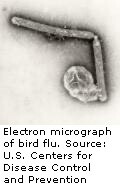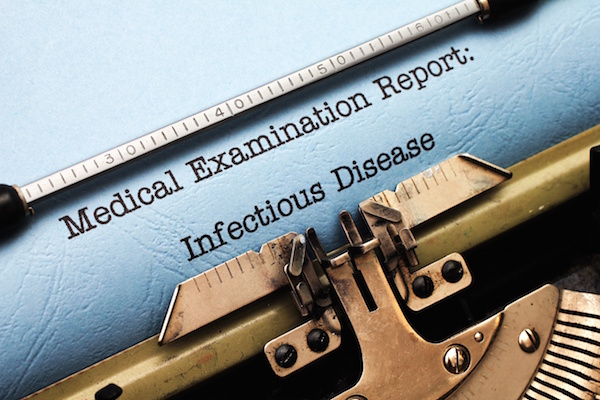
TUESDAY, Jan. 31 (HealthDay News) — Concerns that research into a genetically mutated form of bird flu could escape from labs or fall into the hands of bioterrorists led U.S. scientific advisers to ask two prominent journals to withhold key details of the groundbreaking research, the advisers explained Tuesday.
So far, so-called H5N1 bird — or avian — flu strains have rarely been transmitted from birds to humans since it was first identified in Asia in 1997. But the genetically modified virus created by scientists in the United States and Holland has been shown to be more transmissible in animal experiments, and the fear is that it could also be highly contagious among people, potentially setting the stage for a deadly pandemic.
The U.S. National Science Advisory Board for Biosecurity (NSABB) acknowledged on Tuesday that research into the potential threat of the modified H5N1 bird flu strain “could lead to greater preparedness and potential development of novel strategies for disease control,” particularly if the virus were to mutate naturally.
But, releasing the complete research and results of two scientific papers in full in the journals Nature and Science could expose the United States and other nations to harm, the NSABB said, explaining its request to withhold some data from the public.
Researchers at the University of Wisconsin, Madison and Erasmus University in the Netherlands were able to genetically alter the H5N1 bird flu virus, making it far more transmissible among ferrets, which are often used as research animals because they transmit viruses much the same way humans do.
The NSABB’s main concern about the research “is that publishing these experiments in detail would provide information that could help some person, organization or government to develop similar mammal-adapted influenza A/H5N1 viruses for harmful purposes,” the advisers said in a statement Tuesday.
Such research that could be used for good or bad purposes is called “dual-use research,” the NSABB advisers explained. “We are now confronted by a potent, real-world example,” they said.
“By recommending that the basic result [of the research] be communicated without methods or details, we believe that the benefits to society are maximized and the risks minimized,” the advisers said. “Although scientists pride themselves on the creation of scientific literature that defines careful methodology that would allow other scientists to replicate experiments, we do not believe that widespread dissemination of the methodology in this case is a responsible action.”
The debate came to light in December when the NSABB asked the editors of the two journals to publish the bird flu research in “redacted” form, meaning with key elements blocked out.
The NSABB was created by the federal government after anthrax-laced letters killed five people in 2001 and infected more than a dozen other people.
The scientists behind the bird flu studies agreed earlier this month to a 60-day moratorium on their research. Although they believe their work has a public health benefit, they acknowledge the fear of some governments and others that the genetically altered virus could escape from labs and infect people or fall into the hands of bioterrorists.
This fear has caused a highly unusual debate among governments and scientists over the benefits and risks of the research.
Some scientists and biosecurity experts worry that such a mutated virus could trigger a human pandemic that might rival the Spanish flu outbreak of 1918-19 that killed an estimated 20 million to 40 million people worldwide.
In a letter appearing Jan. 20 in the journals Nature and Science, the bird flu researchers, including Yoshihiro Kawaoka from the University of Wisconsin, Madison, and Ron Fouchier, from Erasmus University in the Netherlands, explained that their work with ferrets has already shown that the H5N1 virus can be genetically manipulated to make it easier to transmit among mammals. No research has been done with humans because it would be unethical.
“No experiments with live H5N1 or H5HA reassortant viruses already shown to be transmissible in ferrets will be conducted during this time,” the scientists said on Jan. 20. “We will continue to assess the transmissibility of H5N1 influenza viruses that emerge in nature and pose a continuing threat to human health.”
The research was being temporarily stopped, the scientists said, because they needed additional time to share with the scientific community the research’s benefits to governments and public health organizations should the virus mutate naturally.
Infectious disease expert Dr. Marc Siegel, an associate professor of medicine at New York University, told HealthDay earlier this month that the bird flu research was important because it could help health authorities better prepare for an outbreak if the virus were to mutate naturally. But he did not see the need to share the research with the general public.
“Manipulating flu in the laboratory to figure out how it is transmitted is valuable,” Siegel said, adding it could lead to a clearer understanding of the virus and possibly new vaccines.
“But that doesn’t mean that even if you know those [genetic] combinations that they are going to lead to the next killer pandemic,” he said. In fact, as a new flu strain spreads it usually weakens, he noted.
Also, the results of the experiments with ferrets don’t mean this virus can be passed on to humans, he said.
“I do believe that restricting information on these genetic manipulations is of value. You should be able to publish this data, but I don’t see the value of making it readily available to the general public,” Siegel said. “It should be exchangeable among scientists, but you have to be very careful.”
However, Siegel doesn’t see the need for a moratorium on the research. “This research has got to be done and it should not be restricted. I don’t believe there should be any moratoriums on science,” he said.
More information
For more on pandemic flu, visit the U.S. National Institutes of Health.

